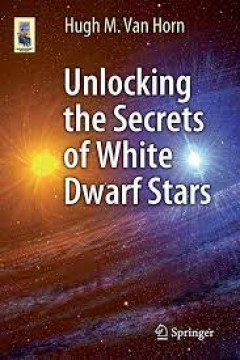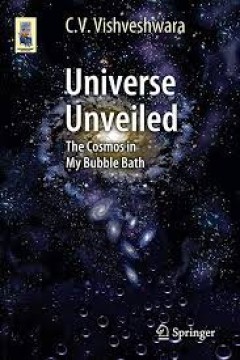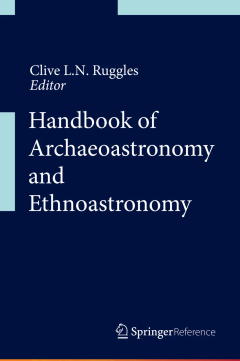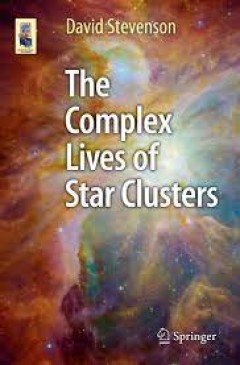Filter by

Unlocking the Secrets of White Dwarf Stars
White dwarfs, each containing about as much mass as our Sun but packed into a volume about the size of Earth, are the endpoints of evolution for most stars. Thousands of these faint objects have now been discovered, though only a century ago only three were known. They are among the most common stars in the Milky Way Galaxy, and they have become important tools in understanding the universe. Ye…
- Edition
- -
- ISBN/ISSN
- 978-3-319-09369-7
- Collation
- 34 b/w illustrations, 37 illustrations in colour
- Series Title
- -
- Call Number
- -

Universe Unveiled The Cosmos in My Bubble Bath
The bubbles were swirling all around me, massaging my body. As I luxuriated in this fantastic bath, I gasped realizing that those bubbles carried with them miniature galaxies bringing the entire Cosmos into my bathtub... Alfie is back. And so are George and other characters from the author’s previous book Einstein’s Enigma or Black Holes in My Bubble Bath. While the present book, Univers…
- Edition
- -
- ISBN/ISSN
- 978-3-319-08213-4
- Collation
- 34 b/w illustrations
- Series Title
- -
- Call Number
- -

Handbook of Archaeoastronomy and Ethnoastronomy
How human communities interpret what they perceive in the sky is vital in fulfilling humankind’s most basic need to comprehend the universe it inhabits, both from a modern scientific perspective and from countless other cultural standpoints, extending right back to early prehistory. Archaeoastronomy, which is concerned with cultural perceptions and understandings of astronomical phenomena, is…
- Edition
- -
- ISBN/ISSN
- 978-1-4614-6140-1
- Collation
- XXXVI, 2297
- Series Title
- -
- Call Number
- 520 HAN

The Formalisms of Quantum Mechanics
Quantum mechanics is probably the most successful physical theory ever proposed and despite huge experimental and technical progresses in over almost a century, it has never been seriously challenged by experiments. In addition, quantum information science ha s become an important and very active field in recent decades, further enriching the many facets of quantum physics. Yet, there is a s…
- Edition
- -
- ISBN/ISSN
- 978-3-319-10539-0
- Collation
- VII, 157
- Series Title
- Lecture Notes in Physics
- Call Number
- -

Dynamics of young star clusters and associations : Saas-Fee advanced course 42
Where do most stars (and the planetary systems that surround them) in the Milky Way form? What determines whether a young star cluster remains bound (such as an open or globular cluster), or disperses to join the field stars in the disc of the Galaxy? These questions not only impact understanding of the origins of stars and planetary systems like our own (and the potential for life to emerge th…
- Edition
- -
- ISBN/ISSN
- 9783662472903
- Collation
- xxiii, 348 pages
- Series Title
- -
- Call Number
- 520

Hollyweird Science: From Quantum Quirks to the Multiverse
Lighthearted, quirky, and upbeat, this book explores the portrayal of science and technology on both the big and little screen -- and how Hollywood is actually doing a better job of getting it right than ever before. Grounded in the real-word, and often cutting-edge, science and technology that inspires fictional science, the authors survey Hollywood depictions of topics such as quantum mechani…
- Edition
- -
- ISBN/ISSN
- 978-3-319-15071-0
- Collation
- XVI, 308
- Series Title
- -
- Call Number
- 523 KEV h

The Complex Lives of Star Clusters
As with the author’s recent books Extreme Explosions and Under a Crimson Sun, the complex topic of star clusters is broken down and made accessible with clear links to other areas of astronomy in a language which the non-specialist can easily read and enjoy. The full range of topics are addressed regarding how star clusters are formed. Why is it some are dense conglomerates of stars while oth…
- Edition
- -
- ISBN/ISSN
- 978-3319142333
- Collation
- -
- Series Title
- -
- Call Number
- -

Eclipses, Transits, and Comets of the Nineteenth Century How America's Percep…
Grabbing the attention of poets, politicians and the general public alike, a series of spectacular astronomical events in the late 1800s galvanized Americans to take a greater interest in astronomy than ever before. At a time when the sciences were not yet as well established in the United States as they were in Europe, this public interest and support provided the growing scientific community …
- Edition
- -
- ISBN/ISSN
- 9783319083414
- Collation
- 345 pages
- Series Title
- -
- Call Number
- 520

Extraterrestrial Intelligence and Human Imagination SETI at the Intersection…
The search for extraterrestrial intelligence (SETI) represents one of the most significant crossroads at which the assumptions and methods of scientific inquiry come into direct contact with—and in many cases conflict with—those of religion. Indeed, at the core of SETI is the same question that motivates many interested in religion: What is the place of humanity in the universe? Both scient…
- Edition
- -
- ISBN/ISSN
- 978-3-319-10551-2
- Collation
- 1 illustrations in colour
- Series Title
- -
- Call Number
- -

Advances in Gamma Ray Resonant Scattering and Absorption: Long-Lived Isomeric…
This book presents the basics and advanced topics of research of gamma ray physics. It describes measuring of Fermi surfaces with gamma resonance spectroscopy and the theory of angular distributions of resonantly scattered gamma rays. The dependence of excited-nuclei average lifetime on the shape of the exciting-radiation spectrum and electron binding energies in the spectra of scattered gamma …
- Edition
- Ed. 1
- ISBN/ISSN
- 978-3-319-10524-6
- Collation
- XI, 192
- Series Title
- Springer Tracts in Modern Physics
- Call Number
- 520 DAV a
 Computer Science, Information & General Works
Computer Science, Information & General Works  Philosophy & Psychology
Philosophy & Psychology  Religion
Religion  Social Sciences
Social Sciences  Language
Language  Pure Science
Pure Science  Applied Sciences
Applied Sciences  Art & Recreation
Art & Recreation  Literature
Literature  History & Geography
History & Geography